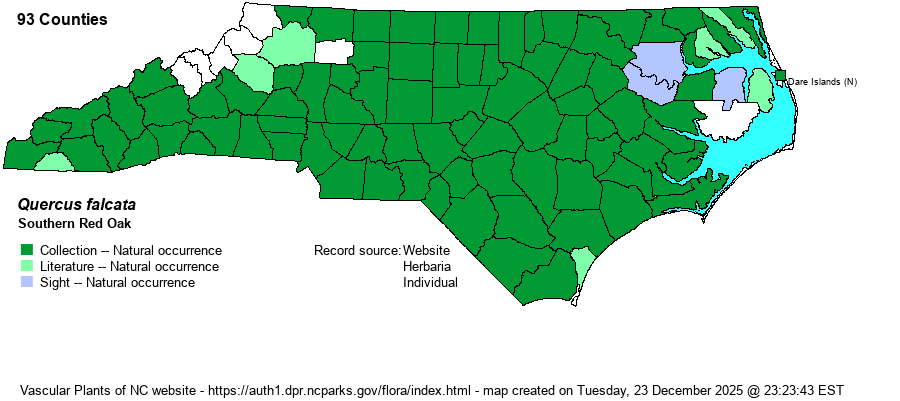| Author | Michaux | |
| Distribution | Nearly statewide, but probably absent in a few northern Mountain counties; likely scarce in some far eastern counties. Certainly absent from the higher elevations (above perhaps 3500 feet).
This is a widespread Southern species, ranging north only to NJ and southern MO, but south to central FL and eastern TX.
| |
| Abundance | Common to very common in the Piedmont and most of the Coastal Plain, but uncommon in the far eastern counties. Fairly common in the lower portions of the southern Mountains, but rare to uncommon in the northern half of the Mountains. One of the most common oaks in the Piedmont and Coastal Plain. | |
| Habitat | This species favors dry upland forests, both in somewhat mesic soils to more frequent in dry soils. In the Sandhills it is found more often in long fire-suppressed upland sites and in the less deep sands; other oaks such as Turkey (Q. laevis), Sand Post (Q. margarettae), Bluejack (Q. incana), and Blackjack (Q. marilandica) are found in more frequently burned and/or sandier sites. |
| Phenology | Flowers in April, and fruits from September to November of the second year. | |
| Identification | This is a very familiar medium to large deciduous tree growing to about 80-95 feet tall. It typically is easily identified by its rather few, triangular lobes with the central one usually quite long and parallel-sided; the lobes have bristle tips. The leaves are usually quite narrow, as well. The base of the leaf is often bell-shaped (strongly convex to a squared base), but it can be rather straight and cuneate. The leaves are rather thick, being shiny dark green above, and rather pale green below. Though many leaves can be variable, in general there should be some leaves on the tree that have such long and rectangular central lobes that confusion with other species is unlikely. Turkey Oak is similar, but its leaves usually do not show a long parallel-sided central lobe, and most leaves are oriented perpendicular to the ground. It is a much smaller tree and grows in fairly deep sands. | |
| Taxonomic Comments | Essentially none, though a few decades ago the Cherrybark Oak (Q. pagoda) was often merged into this species, with the varietal name as Q. falcata var. pagodaefolia (e.g., RAB 1968). Nearly all recent references have these two as good species.
| |
| Other Common Name(s) | Spanish Oak | |
| State Rank | S5 | |
| Global Rank | G5 | |
| State Status | | |
| US Status | | |
| USACE-agcp | FACU link |
| USACE-emp | FACU link |

